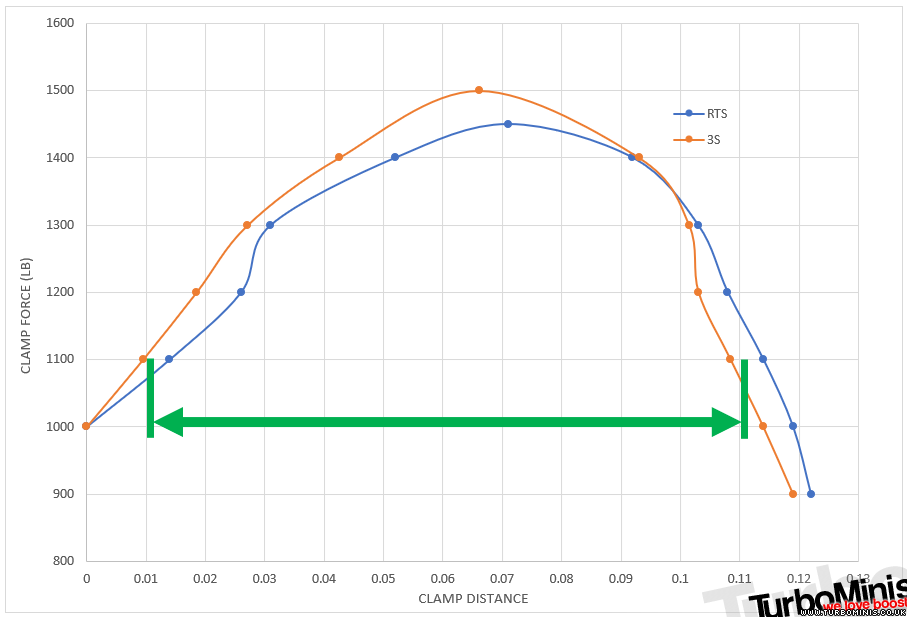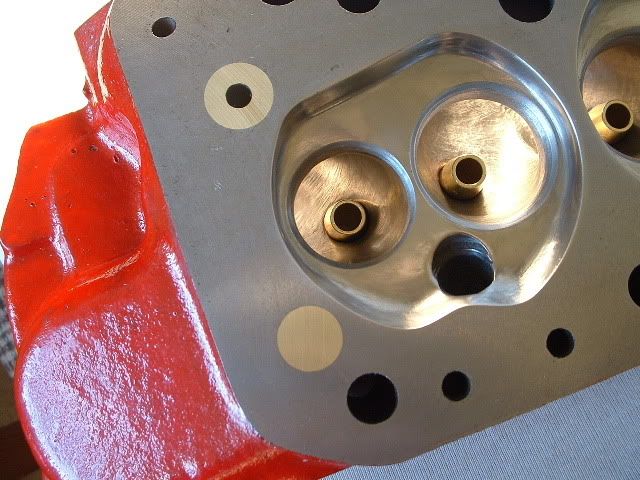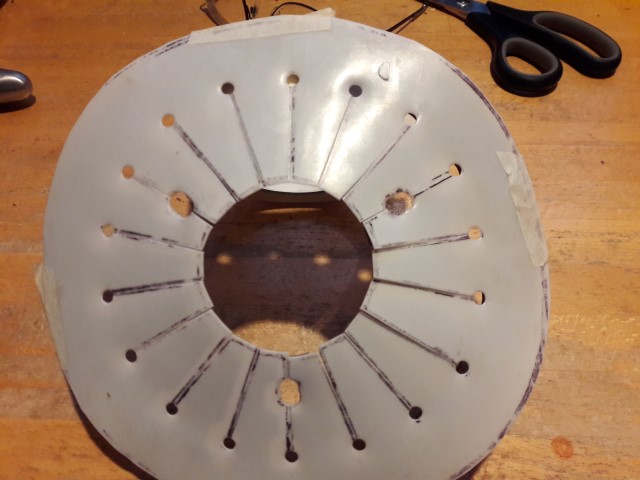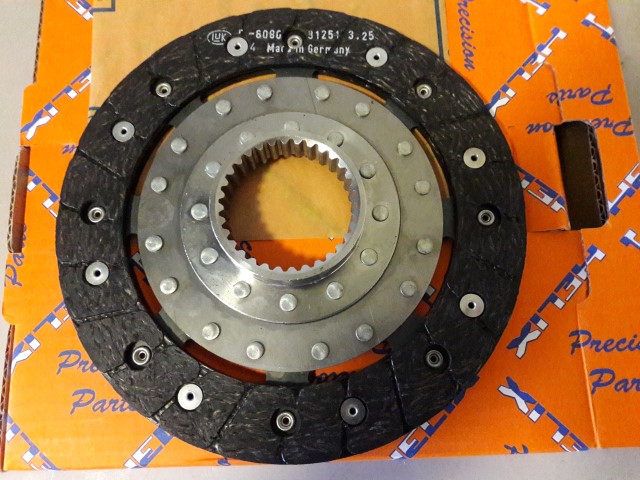| Page: |
| Home > Technical Chat > Clamp / Release force comparisons - Grey vs Turbo vs RTS vs 3S | |||||||
|
Forum Mod 10979 Posts Member #: 17 ***16*** SouthPark, Colorado |
29th Mar, 2018 at 05:25:43am
So, I figured I'd post my findings here.
Edited by TurboDave16V on 29th Mar, 2018. On 17th Nov, 2014 Tom Fenton said:
Sorry to say My Herpes are no better Ready to feel Ancient ??? This is 26 years old as of 2022 https://youtu.be/YQQokcoOzeY |
||||||
 12307 Posts Member #: 565 Carlos Fandango Burnham-on-Crouch, Essex |
29th Mar, 2018 at 08:06:26am
thats damn interesting Dave,
On 28th Aug, 2011 Kean said:
At the risk of being sigged... Joe, do you have a photo of your tool? http://www.turbominis.co.uk/forums/index.p...9064&lastpost=1 https://joe1977.imgbb.com/ |
||||||
|
Forum Mod 10979 Posts Member #: 17 ***16*** SouthPark, Colorado |
29th Mar, 2018 at 01:29:39pm
The fact that you had to extend the arm, makes it clear that the release load is "up there"...
Edited by TurboDave16V on 29th Mar, 2018. On 17th Nov, 2014 Tom Fenton said:
Sorry to say My Herpes are no better Ready to feel Ancient ??? This is 26 years old as of 2022 https://youtu.be/YQQokcoOzeY |
||||||
 (2)[/url] by [url=https://www.flickr.com/photos/150672766@N03/]Rod Sugden[/url], on Fli) 5988 Posts Member #: 2024 Formally Retired Rural Suffolk |
29th Mar, 2018 at 01:50:13pm
Yes, extending the arm for the RTS is the way to go for a reasonable pedal. The trouble with the actual Metro one is the angle of the ends is all wrong so the slave has to be re-located but, having said that, even if you just extend a Mini verto arm the slave has to be raised to keep the pushrod parallel to the cylinder.
Schrödinger's cat - so which one am I ??? |
||||||
 12307 Posts Member #: 565 Carlos Fandango Burnham-on-Crouch, Essex |
29th Mar, 2018 at 02:06:09pm
well my RTS was never over the top weight wise, IIRC its 2x 1275 springs, but theres people out there running 2x turbo springs and that would be a bit hard going!
On 28th Aug, 2011 Kean said:
At the risk of being sigged... Joe, do you have a photo of your tool? http://www.turbominis.co.uk/forums/index.p...9064&lastpost=1 https://joe1977.imgbb.com/ |
||||||
|
Forum Mod 10979 Posts Member #: 17 ***16*** SouthPark, Colorado |
29th Mar, 2018 at 04:30:53pm
On 29th Mar, 2018 Joe C said:
This "3S" clutch, is that Verto or Preverto based?? also do we know what the MED and Mispares lightweight verto post heights are? I think its mentioned somewhere, i'll have a dig later if no one knwos off hand. The 3S is verto based. My old flywheel design I was working on back in 2006 (using the same 3S spring) basically came full circle, and ended up looking like a verto, so I re-designed it around the verto stuff. The MS Verto lightweight post heights are same as standard - 23.5mm I found they needed to be reduced to 21.7mm for "my" optimal clamping preference. The dowels need to be removed to machine the posts, and (on my MS plate) they are in there TIGHT. I had to put a 3/8 nut over them, plug weld, and twist and pry to get them out. They are simple 8mm dowels however. As i mentioned, I had 2.4 and 2.2mm springs - I believe that is a turbo and a 1275. Edited by TurboDave16V on 29th Mar, 2018. On 17th Nov, 2014 Tom Fenton said:
Sorry to say My Herpes are no better Ready to feel Ancient ??? This is 26 years old as of 2022 https://youtu.be/YQQokcoOzeY |
||||||
|
Forum Mod 10979 Posts Member #: 17 ***16*** SouthPark, Colorado |
29th Mar, 2018 at 04:37:11pm
On 29th Mar, 2018 Rod S said:
One other trick I've added - again, yet to be proven - is a 0.5mm sheet of PTFE cut into a circle with "fingers just like the springs, between the springs. Same principle as the lead pencil trick but hopefully longer lasting.       
That there is a good idea. Yes, PTFE takes high temps for sure, we use UHMW on all conveyors, but switch to PTFE in the oven conveyors. I imagine that polishing up the faces will also be of benefit. I feel like the lubricant alone will not make a huge difference, as it's simply going to contact on the highest (rough) points of the rough metal springs, and that pressure (and surface rougnmess will negate the dry (graphite) or wet (grease) lubricant. The PTFE will definitely aid compliance. I'm also wondering about cutting pockets into the area between the fulcrum pivots (the wire rings) leaving an assured full contact at the wire and outer perimeter, but allow the other areas to move closer (if they need). Edited by TurboDave16V on 29th Mar, 2018. On 17th Nov, 2014 Tom Fenton said:
Sorry to say My Herpes are no better Ready to feel Ancient ??? This is 26 years old as of 2022 https://youtu.be/YQQokcoOzeY |
||||||
|
3569 Posts Member #: 655 Post Whore Northern Ireland |
30th Mar, 2018 at 12:13:21am
As much as you're measuring at that clutch thickness ( I actually thought a new disc was thicker ? but it's been near 20 years since I measured one )...
9.85 @ 145mph
|
||||||
|
Forum Mod 10979 Posts Member #: 17 ***16*** SouthPark, Colorado |
30th Mar, 2018 at 03:02:13am
On 30th Mar, 2018 stevieturbo said:
As much as you're measuring at that clutch thickness ( I actually thought a new disc was thicker ? but it's been near 20 years since I measured one )... Have you tried to see at what cover position offers the most clamp load ? ie would a thicker or thinner starting disc be better, or a height adjustment needed on the flywheel posts ? I measured the AP race/rally plate. When squeezed together, it is indeed .280" (7.1mm).It is thicker when not squeezed, of course, but that is not representative. I have indeed played with the post height. This pic shows the clamp force. The curve goes from the left to the right for the spring relaxing - that is to say a worn clutch would be on the right, a new clutch on the left. I adjusted my posts so at .280" thick, it'll be at the left green marker, and as it wears, clamp force increases, then decreases. I could instead have set it up to be at the peak at .280", but as you can see, it'd fall off the peak clamp quickly... 
It really is interesting how close the RTS and 3S clutches are!!! Edited by TurboDave16V on 30th Mar, 2018. On 17th Nov, 2014 Tom Fenton said:
Sorry to say My Herpes are no better Ready to feel Ancient ??? This is 26 years old as of 2022 https://youtu.be/YQQokcoOzeY |
||||||
 11046 Posts Member #: 965 Post Whore Preston On The Brook |
30th Mar, 2018 at 08:53:17am
The MED flywheel I had, needed the posts machining down to get the springs flat, but the standard MPi flywheel was spot on. The after market flywheels boast “greater clamping” but couldn’t get my head round that. It’s basically bullshit. What they have done is put the spring into its peak clamping force region. On 26th Oct, 2004 TurboDave16v said:
Is it A-Series only? I think it should be... So when some joey comes on here about how his 16v turbo vauxhall is great compared to ours, he can be given the 'bird'... On 26th Oct, 2004 Tom Fenton said:
Yep I agree with TD........ |
||||||
|
Forum Mod 10979 Posts Member #: 17 ***16*** SouthPark, Colorado |
30th Mar, 2018 at 02:47:53pm
Well they probably are claiming that because they realised (as I did) that the springs flat point, is not the greatest clamping force.
Edited by TurboDave16V on 30th Mar, 2018. On 17th Nov, 2014 Tom Fenton said:
Sorry to say My Herpes are no better Ready to feel Ancient ??? This is 26 years old as of 2022 https://youtu.be/YQQokcoOzeY |
||||||
 12307 Posts Member #: 565 Carlos Fandango Burnham-on-Crouch, Essex |
30th Mar, 2018 at 03:32:32pm
Loving the PTFE sheet idea Rod!
On 28th Aug, 2011 Kean said:
At the risk of being sigged... Joe, do you have a photo of your tool? http://www.turbominis.co.uk/forums/index.p...9064&lastpost=1 https://joe1977.imgbb.com/ |
||||||
|
Forum Mod 10979 Posts Member #: 17 ***16*** SouthPark, Colorado |
30th Mar, 2018 at 04:25:51pm
Indeed it would.
Edited by TurboDave16V on 30th Mar, 2018. On 17th Nov, 2014 Tom Fenton said:
Sorry to say My Herpes are no better Ready to feel Ancient ??? This is 26 years old as of 2022 https://youtu.be/YQQokcoOzeY |
||||||
 (2)[/url] by [url=https://www.flickr.com/photos/150672766@N03/]Rod Sugden[/url], on Fli) 5988 Posts Member #: 2024 Formally Retired Rural Suffolk |
30th Mar, 2018 at 04:44:49pm
Joe, I've found an old photo and tried to upload it to flickr
Schrödinger's cat - so which one am I ??? |
||||||
|
Forum Mod 10979 Posts Member #: 17 ***16*** SouthPark, Colorado |
30th Mar, 2018 at 05:00:17pm
I can buy PTFE sheet stuff easily statside:
Edited by TurboDave16V on 30th Mar, 2018. On 17th Nov, 2014 Tom Fenton said:
Sorry to say My Herpes are no better Ready to feel Ancient ??? This is 26 years old as of 2022 https://youtu.be/YQQokcoOzeY |
||||||
 (2)[/url] by [url=https://www.flickr.com/photos/150672766@N03/]Rod Sugden[/url], on Fli) 5988 Posts Member #: 2024 Formally Retired Rural Suffolk |
30th Mar, 2018 at 05:16:32pm
Dave,
Schrödinger's cat - so which one am I ??? |
||||||
|
Forum Mod 10979 Posts Member #: 17 ***16*** SouthPark, Colorado |
30th Mar, 2018 at 05:41:25pm
Excellent. On 17th Nov, 2014 Tom Fenton said:
Sorry to say My Herpes are no better Ready to feel Ancient ??? This is 26 years old as of 2022 https://youtu.be/YQQokcoOzeY |
||||||
|
Forum Mod 10979 Posts Member #: 17 ***16*** SouthPark, Colorado |
30th Mar, 2018 at 05:46:53pm
What is the ID. of the friction lining of that plate? Edited by TurboDave16V on 30th Mar, 2018. On 17th Nov, 2014 Tom Fenton said:
Sorry to say My Herpes are no better Ready to feel Ancient ??? This is 26 years old as of 2022 https://youtu.be/YQQokcoOzeY |
||||||
 12307 Posts Member #: 565 Carlos Fandango Burnham-on-Crouch, Essex |
30th Mar, 2018 at 05:52:02pm
Nice one Rod, not as thick as i thought.
On 28th Aug, 2011 Kean said:
At the risk of being sigged... Joe, do you have a photo of your tool? http://www.turbominis.co.uk/forums/index.p...9064&lastpost=1 https://joe1977.imgbb.com/ |
||||||
 (2)[/url] by [url=https://www.flickr.com/photos/150672766@N03/]Rod Sugden[/url], on Fli) 5988 Posts Member #: 2024 Formally Retired Rural Suffolk |
30th Mar, 2018 at 06:06:38pm
Joe, Yes they look thicker until you clamp them to do the measurement Dave was after because of the wavy spring plate in the middle.
Schrödinger's cat - so which one am I ??? |
||||||
|
Forum Mod 10979 Posts Member #: 17 ***16*** SouthPark, Colorado |
30th Mar, 2018 at 09:59:29pm
For reference, the AP Road/Rally C-AHT595 measures 181mm OD X 133.5mm ID x 7.1mm thick
On 17th Nov, 2014 Tom Fenton said:
Sorry to say My Herpes are no better Ready to feel Ancient ??? This is 26 years old as of 2022 https://youtu.be/YQQokcoOzeY |
||||||
 4619 Posts Member #: 20 My sister is so fit I won't show anyone her picture Lake District |
30th Mar, 2018 at 10:00:36pm
Great stuff Dave, thanks for sharing. While we're on the subject of clutches I knocked this up a while ago & would appreciate peoples thoughts on accuracy ......
|
||||||
|
Forum Mod 10979 Posts Member #: 17 ***16*** SouthPark, Colorado |
30th Mar, 2018 at 10:26:59pm
Phil,
Edited by TurboDave16V on 30th Mar, 2018. On 17th Nov, 2014 Tom Fenton said:
Sorry to say My Herpes are no better Ready to feel Ancient ??? This is 26 years old as of 2022 https://youtu.be/YQQokcoOzeY |
||||||
 4619 Posts Member #: 20 My sister is so fit I won't show anyone her picture Lake District |
30th Mar, 2018 at 10:31:10pm
Cheers for the feedback Dave. So aside from what you said above, the rest looks in the "ballpark" to you?
|
||||||
|
3569 Posts Member #: 655 Post Whore Northern Ireland |
31st Mar, 2018 at 11:06:44am
On 30th Mar, 2018 TurboDave16V said:
Well they probably are claiming that because they realised (as I did) that the springs flat point, is not the greatest clamping force. I think there is some misunderstanding about the diaphragm, and probably only recently learned it myself. I had previously thought a clutch would install pretty close to flat...and that the release mech would push to flat and beyond to disengage drive. Seems that is nowhere near correct. Clutch fingers installed should not be flat...and indeed nor should they ever go flat or beyond even to disengage. The spring should always remain less than flat, going beyond will stress and wear the spring more quickly. The diaphragm should never go over centre apparently. So as I'm sure Dave noted....max clamp will actually be some distance prior to flat fingers I tested my ACT cover a few months back and was surprised at where max clamp actually was, as I thought because my disc pack was worn to the tune of around 1mm total ( twin plate )....this was the reason it started slipping on me and removing shims from the posts might restore clamp. But if anything at that "worn" installed height, clamping force on the discs would be higher than anywhere else and the clutch fingers were at a fair angle. It just wasnt strong enough in my case. 9.85 @ 145mph
|
||||||
| Home > Technical Chat > Clamp / Release force comparisons - Grey vs Turbo vs RTS vs 3S | |||||||
|
|||||||
| Page: |





